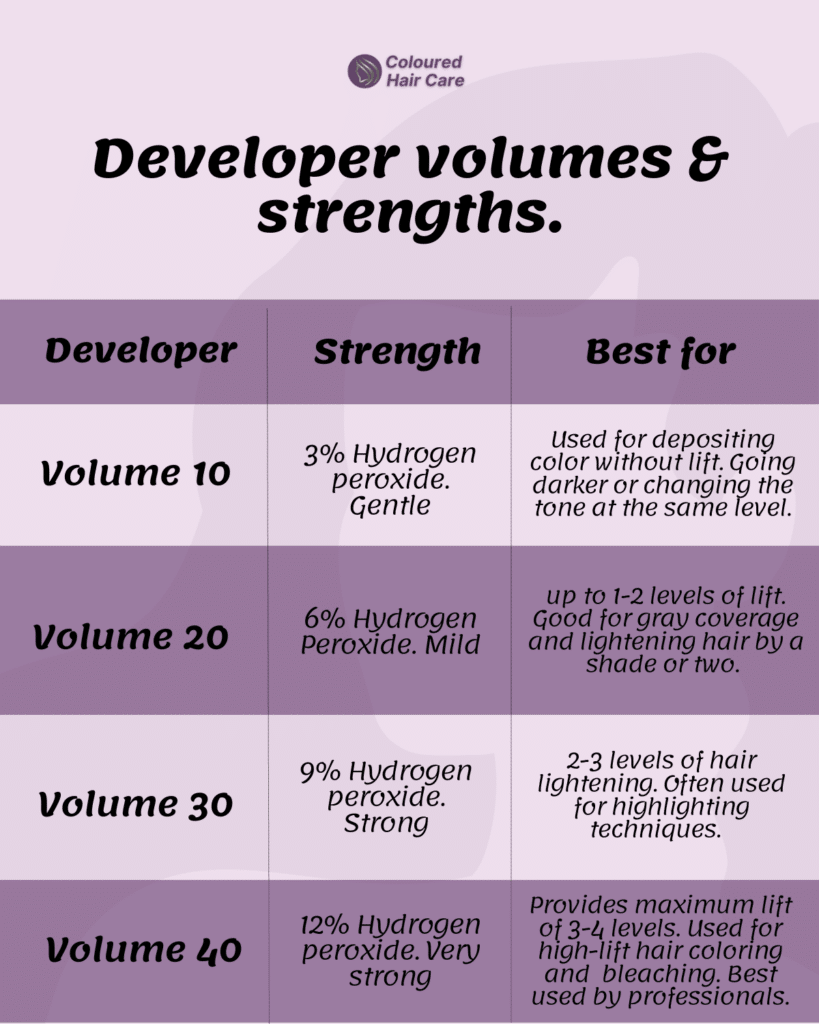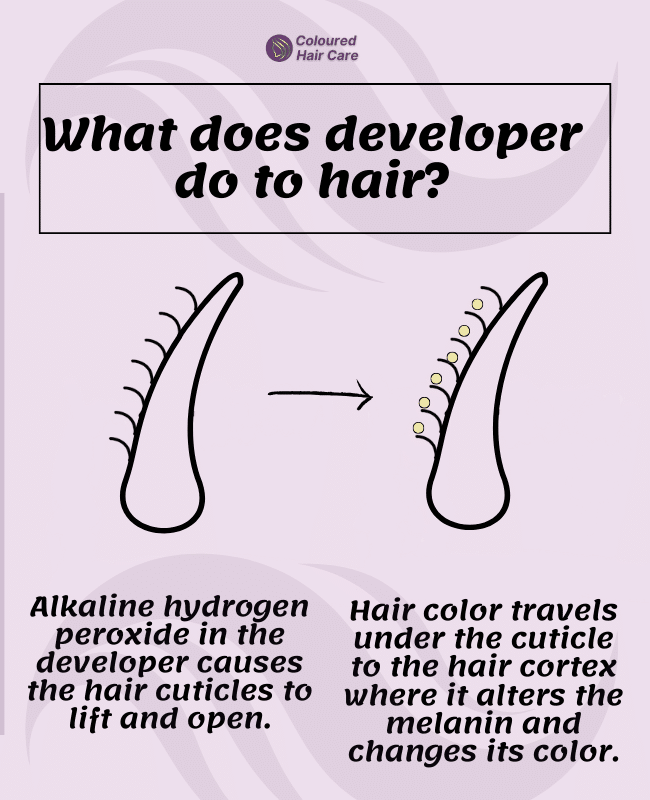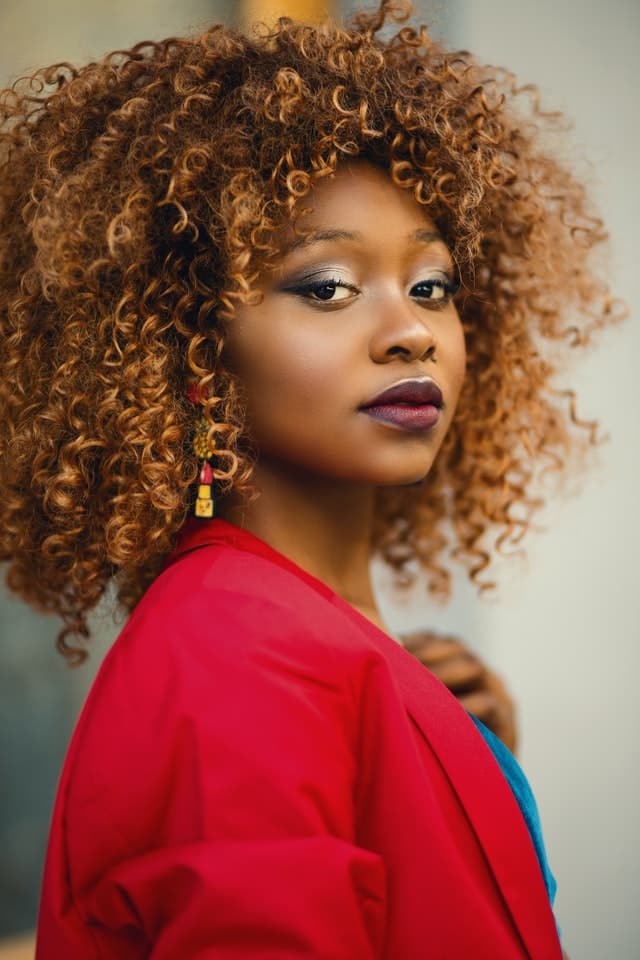I’m sure you’ve been there, in the salon chair with your stylist and she’s telling you about what kind of developer she’s using. You’re like “huh?” Well, we’re here to explain it all. What does developer do to your hair? Read on!
Can developer damage your hair? What do the different volume levels mean? And which one do you need?
We’re here to answer all of these questions, so you can make the right decision for you. Let’s go!
Table of Contents
- What is hair developer?
- How does hair developer worK?
- What the experts say:
- Watch and learn: How does hair developer work?
- What does volume 10 developer do to your hair?
- What does 20 developer do to hair?
- What does 30 hair developer do?
- What does 40 volume developer do?
- What happens if you just put developer in your hair?
- Hair developer TOP TIPS
- Is developer bad for hair?
- Hair Developer Dos and Don’ts.
- Parting words.
What is hair developer?
In the hair industry, a developer is an agent that alters the color of hair by removing or changing its pigment.
It’s used to lighten hair, remove unwanted tones and create different colors.
It can be found in many forms: as a lotion, cream rinse or powder that you mix with bleach.
How does hair developer worK?
Developers are made up of hydrogen peroxide and come in several strengths – 10%, 20%, 30%,40% and even 50% (never use this!).
According to All About The Gloss, developer works by breaking down the hair shaft with chemicals and opening up the hair cuticle. After the hair cuticle is open, it can absorb the hair color or bleach.
As explained by WebMD, Hair color will fill the hair and bleach removes color from the hair.
If you apply color without it, it won’t be able to penetrate and stay inside the hair shaft. The most it will do is stain the hair.
Developer is mixed with color and hair dye pigment to deposit the colour onto your hair. It ‘develops’ the dye – that’s why they call it developer!
What the experts say:
Expert Insights
“Haircolor developer contains hydrogen peroxide. Low volumes of developer develop the dye. That’s why they call it developer.”
John Halal, Founder, President – ChemistrySimplified.com
“Hair dye without a developer is like cooking without heat. Note: temporary dyes and direct dyes do not need a developer.”
Barbara Forgione, Hair Colorist & Colour Bunz creator
“The developer is used to lighten the melanin of hair so that the color you want to deposit comes out true to the shade it’s supposed to be. It also accelerates the formation of the dyes inside the hair.”
Lorna N. Casse, Owner of Hairmomentum.com, Hair Care Consultant, Chemist

Watch and learn: How does hair developer work?
Here’s a great video tutorial that tells you exactly how the hair coloring process works step by step.

What does volume 10 developer do to your hair?
10 volume can be used with permanent color hair dyes for depositing color, but it will not offer much grey coverage or lift.
However, volume 10 is the default developer in many hair toners and glazes.
When mixed with bleach, volume 10 can give you 1-4 levels of lift may result depending on how you apply your hair bleach.
It’s the most used for more subtle hair colour changes like from dark brown to light brown, red to strawberry blonde and even caramel to honey blonde.
What does 20 developer do to hair?
20 volume is the most popular choice for permanent hair color. It can give up 1-2 levels of lift on finer hair.
It’s also a good option for grey hair coverage. However, some hair types resist this product better than others! If you have a lot of stubborn greys, you likely need something stronger.
Volume 20 is probably the most common strength used in salons. It’s no good for hair toners and glazes though.
When used with bleach, it’s pretty powerful and can lift your hair up to 9 levels. It’s good for going from dark brown to light brown, adding highlights and balayage colours, and lifting unwanted colours.
What does 30 hair developer do?
30 volume is getting into the strong stuff. This isn’t the one to use to deposit colour into your hair as it will fry it for no reason.
Volume 30 is good for bleaching dark hair.
30 volume and higher can react really strongly to heat. So you need to be careful with processing treatments like foil highlights to avoid damaging your hair.
It’s also a good strength to use for stubborn grey hair, depending on the texture and health of your hair.
What does 40 volume developer do?
40 volume is reserved for the kind of very thick and dark hair like black that needs a higher intensity strength.
If you try to use it on hair that is medium to fine thickness all you will do is overprocess and burn the hair.
40 Volume is pretty serious stuff. It’s extremely harsh on the hair and the reason why you have to leave it on for less time than others.
It strips the hair of colour and can also remove all the moisture in your hair. It can be used to get a great base for super icy-shite blondes like platinum.
It is a good strength to use for techniques like balayage and ombre where it isn’t close to your scalp or all over your hair.
What happens if you just put developer in your hair?
Developer is made of varying strengths of hydrogen peroxide which are hair lightening chemicals.
So in theory, it can be used to lighten your hair on its own. But we wouldn’t recommend this!
That doesn’t mean that it SHOULD be used to lighten your hair.
It will require heat and has to stay wet in the hair for quite a while for there to be much effect, and the resulting color will be brassy and your will probably end up feeling like straw.
So while it’s less damaging than colouring due to the lack of ammonia, it still impacts your hair integrity for a result that is very brassy and ick.
Hair color is all about mixing the chemicals to the perfect ratio.
You need to activate the developer with color – lighter color, darker color or bleach – otherwise the effort is not worth the results.
Expert Insights
“If you apply color without a developer it will roll off and it doesn’t have anyway to stay inside the hair shaft. The most it wi do is stain the hair.”
Sharon Allred Williams, Managing Cosmetologist
Hair developer TOP TIPS
The higher the volume, the stronger the chemicals and the more the developer will lift your hair.
Don’t use a stronger volume than you need as it will damage your hair for no reason!
Mix developer with Olaplex to strengthen your hair bonds and prevent any breakage or damage.
Is developer bad for hair?
Think of the volume as the amount of lift or lightening you want to achieve.
Using too high of a volume can result in unnecessary lightening and major damage to the hair. Too low a volume, and you may not get as light as you want.
Over 30 volume can be too strong and cause burns if it touches your scalp.
30 volume developers and above are typically used on dark hair, while lower volumes, such as 10 and 20, are used for naturally lighter hair.
Like any hair colouring product, hair developer can damage your hair if not used carefully. Always make sure your hair condition is up for having chemicals applied to it.
And give your hair lots of TLC before, during and after bleaching or coloring!
Hair Developer Dos and Don’ts.
Dos:
- Do Test First: Always perform a strand test to gauge how your hair reacts to the developer, especially if you’re trying a new volume or brand.
- Do Choose the Right Volume: Select a developer volume suitable for your hair type and desired result. Lower volumes for subtle changes, higher for more significant lightening.
- Do Follow Instructions: Carefully read and adhere to the instructions on the developer and hair color products.
- Do Use Quality Products: Invest in good quality developers and hair colors to ensure better results and minimize potential damage.
- Do Protect Your Scalp and Skin: Apply a barrier cream around your hairline and wear gloves to protect your skin from irritation.
- Do Condition Your Hair: After using a developer, condition your hair thoroughly to restore moisture and maintain its health.
- Do Mix with Hair Bond Strengtheners: Consider mixing your developer with products like Olaplex to protect and strengthen hair bonds during the coloring process.
Don’ts:
- Don’t Overuse: Avoid frequent use of high-volume developers as they can significantly damage your hair.
- Don’t Use on Damaged Hair: If your hair is already damaged, brittle, or over-processed, refrain from using strong developers.
- Don’t Guess the Timing: Never leave the developer in your hair longer than recommended, as over-processing can lead to severe hair damage.
- Don’t Neglect Aftercare: Failing to properly care for your hair post-treatment can lead to dryness and breakage.
- Don’t Ignore Adverse Reactions: If you experience any discomfort, burning, or unusual reactions, rinse out the developer immediately.
- Don’t Mix Randomly: Avoid mixing developers of different brands or types without professional advice, as this can lead to unpredictable results.
- Don’t Use High Volumes Without Experience: High-volume developers (like 40 volume) should be used with caution and preferably by professionals.
Useful Resources.
For further understanding of how hair developers work and their effects on different hair types, you might find these resources insightful:
- American Academy of Dermatology: Offers comprehensive information on hair care and the effects of various hair treatment chemicals.
- Hair Science by the Trichological Society: Provides detailed scientific insights into hair structure and how hair coloring products interact with it.
- Cosmetic Ingredient Review: Offers in-depth analysis and safety information on cosmetic ingredients, including hydrogen peroxide used in hair developers.
Parting words.
We hope this article has helped you to better understand what developers do for your hair.
Whether you’re thinking of going from really dark to really light, ombre, balayage, or just adding some highlights and texture, we hope you now know how to find the right level for you.
Good luck!

